March 2009 Archives
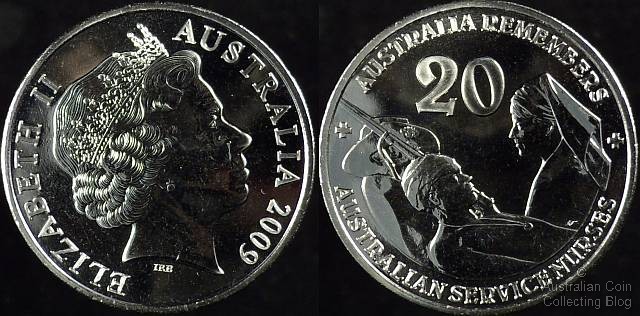
The 2009 Service Nurses 20 cent
This 2009 commemorative 20 cent piece was released by the Royal Australian Mint featuring one of our Service Nurses tending to a wounded digger.
It pays tribute to the tireless efforts of our service nurses (not just women!) throughout all our war efforts from the Boer War right up until now in Afghanistan. Remembering these unsung heroes of war helping our wounded diggers so they can be reunited with their families.
It's not to be issued in any of the sets nor into circulation so it's sure to be a rarer issue -of course depending on the mintage which is yet to be stated by the RAM. Military themed issues do tend to be winners in the public eye but we'll have to wait and see.
This 20 cent is the standard Cupro-Nickel composition 28.52 millimetres in diameter weighing in at 11.31 grams. This is one of those issues never to be found in your change so the only way you'll get one is housed in the special card as issued by the RAM in brilliant uncirculated condition for $6.95 issue price.
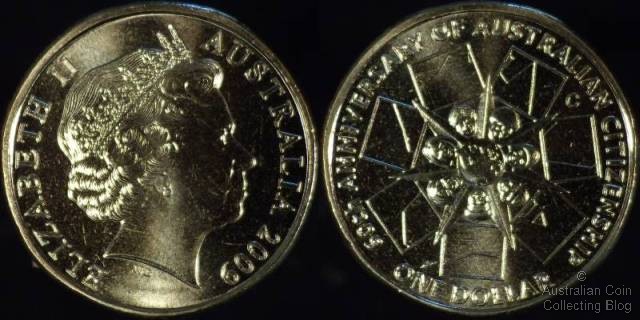
Australian 2009 Citizenship Dollar 'C' Mintmark
Each year the Royal Australian Mint has a themed coin for the year that is available with a range of mintmarks, counterstamps and privy marks. This year it is the Citizenship Dollar. If you visit the mint in Canberra then you'll have the chance to mint your own 'C' mintmark coin on one of the gallery presses. You can also purchase a 'C' mintmark coin from the mint shop. Interestingly, the reeding on the edges of each of these three coins is aligned differently with respect to the design on each side of the coin. It is my understanding that the interrupted reeding on the edge of Australian $1 coins is formed as part of the minting process by the collar.
Now, I am no expert on the minting process and dont really know if the collar can be fitted in any orientation to the coining press. If this is the case, then the alignment of the reeding would be completely random for each die setup. However, if it is fitted with design features that key into the coining press then alignment would be fixed for each press or fixed for each die combination. The reason I'm talking about this is that some dollar coin collectors insist that to have a complete dollar set then you must have a 'C' mintmark coin from each gallery press AND the normal production presses. To this end I've taken some images of coins minted from each gallery press and the normal production coin.
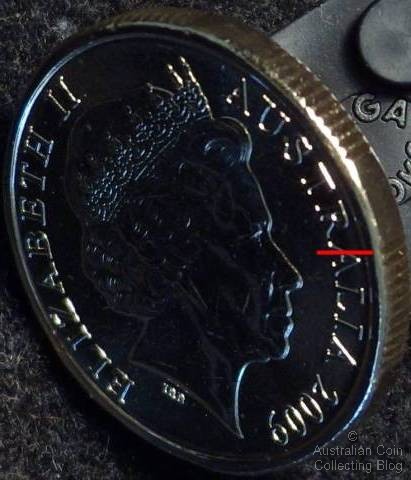
Production Press 'C' Mintmark
The above coin is from the normal production presses. You can see that the commencement of the reeding pretty much coincides with the first and second A in Australia.
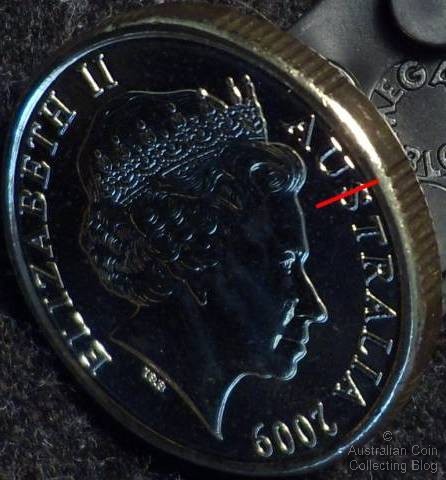
Gallery Press 1 'C' Mintmark
The above coin is from gallery press 1. You can see that the commencement of the reeding cuts through the middle of the S in Australia.
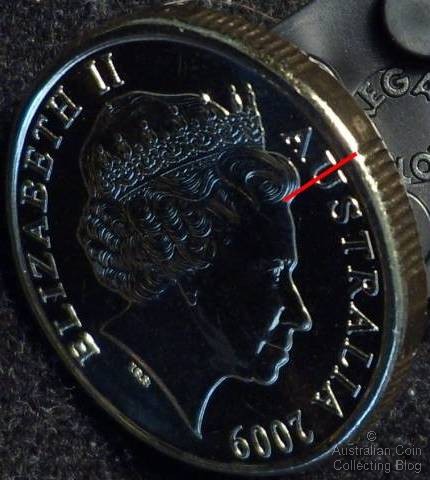
Gallery Press 2 'C' Mintmark
The above coin is from gallery press 2. You can see that the commencement of the reeding cuts through the middle of the U in Australia.
Now my contention with dollar collectors who insist on having the gallery press 1 and 2 coins as 'varieties' required for a complete collection is do they actually know if the reeding position varies in normal production coins? After all, if they do, dont they require a production dollar coin with each reeding position? What if reeding is completely random? Well that means the 'complete' collection is essentially dependent on how many die runs made for a years production of dollar coins!!! Below is an image of a sample of dollar coins I had lying about that certainly does suggest that reeding position varies among production coins too!

A Sample of Circulation Dollars
So we can see from this that the reeding seems to be the same for the 2003, 2006, and the second 2008 coins. The 2007 and 2008 coins also appear to match up. The third 2008 coin is different from all the others. It is also interesting to note that none of these coins matches the reeding positions on the production press 'C' mintmark coin shown above. So what's to be concluded from this?
1. Possibly reeding position is completely random depending on a particular die setup.
2. Possibly reeding is dependent on the coining press into which a die set is fitted.
3. Possibly reeding is dependent on each die 'collar' that is manufactured.
Someone who has a working relationship with the RAM should probably query this so that dedicated collectors can decide if collecting coins by varying reeding position is really worthwhile or entirely fruitless. Until then, saying that you definitely need a gallery press 1 & 2 coin for a complete dollar set neither wrong nor right. If you insist that it is required then you must hunt for normal circulation dollars with different reeding positions. Alternately you could decide that it's a pointless exercise and decide that a mint your own 'C' mintmark is required as is a production 'C' mintmark. Which gallery press the MYO coin comes from doesn't really matter at all!
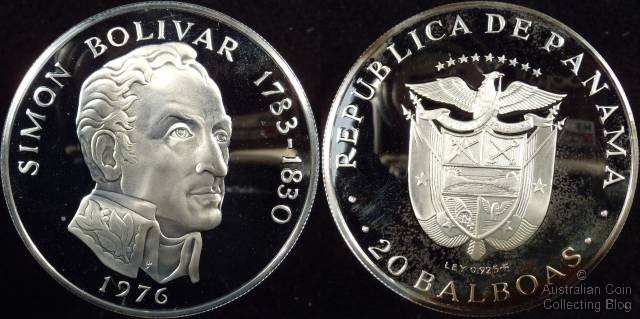 Panama 1976 Proof 20 Balboa
Panama 1976 Proof 20 Balboa
Shown above is a 1976 Panamanian 20 balboa coin struck to proof standard. It was minted from 129.6 grams of 0.925 fine silver (sterling silver) which converts to 3.85 ounces of silver. At the time of writing the silver content of this coin was worth about US$52. The obverse of the coin depicts Simon Bolivar, who was a leading figure in the struggle for independence of Spanish America. The country of Bolivia is named after him. The reverse depicts the great seal of Panama . The first thing to note about these coins is the sheer size. The coin is 61 millimetres in diameter, compare this with 32 millimetres for the Australian 50 cent and 30.6 millimetres for the US Half Dollar. It is simply massive, among the bigger coins minted in history. The coins were minted from 1971 through to 1985. However from 1980 they were minted from 0.500 fine silver rather than the sterling standard and the weight dropped to just under 120 grams.
I have a couple of these coins. The proof one shown above, and a regular circulation coin. The circulation coins don't have the normal polished appearance that most coins do, but instead have an all matte appearance. I cannot emphasize exactly how big these things are, each coin is a handful by itself. Consequently they are impossible to put in a holder and mine reside in paper envelopes where, sadly, they are hardly ever looked at. Mintages are small for almost every issue, ranging from just 500 for the 1984 uncirculated issue (celebrating the 200th anniversary of the birth of Bolivar) up to 161,000 for the 1974 proof issue. The higher issue coins are usually available at little more than the value of the silver they contain. The smaller mintages do have a numismatic premium, but given the low mintages and how infrequently they appear on the market I believe they are undervalued. Great coins, the 20 balboa's, massive discs of silver, everyone should have one. And given their low cost there's no reason not to.
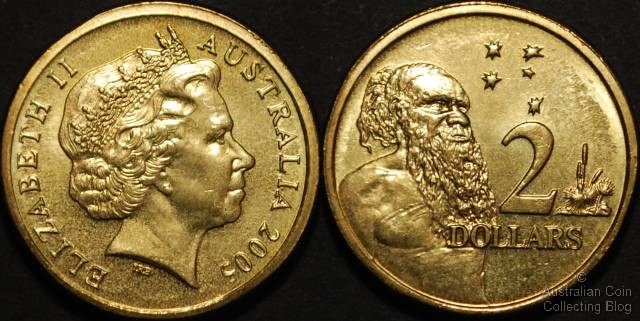 Australia 2005 $2
Australia 2005 $2The Australian two dollar coin was introduced on 20th June 1988 replacing the $2 note that was withdrawn from circulation. As with the one dollar note, the $2 note had a short service life and replacement with a coin was very cost effective. The two dollar coin standard design is that of an aboriginal elder and was the only design used until 2012 when the Mint began a run of commemorative $2 coins, some with colour printing.
It is smaller than the dollar coin at 20.62 millimetres but a fatter little coin with interrupted reeding on it's edge. This width and the different reeding is to help those visually impaired distinguish the difference between it and the dollar coin. It's comprised of 6.6 grams of 92% copper, 6% aluminium and 2% nickel.
The standard reverse design is of an aboriginal elder designed by Horst Hahne. Mr Hahne used his own adaptation of a drawing of an aboriginal elder, Gwoya Jungarai (1895-1965) nicknamed One Pound Jimmy depicted by artist Ainslie Roberts. The coin is not meant to feature anyone in particular, this was just the inspiration the designer used. For the first 2 years of issue only (1988 and 1989) the designers initials HH appeared on the reverse. For all other years following it was removed. The coin also features the southern cross and native Australian flora the grass tree. The obverse differs slightly with the varying effigies of Queen Elizabeth II over the years. It was first issued with the Raphael Maklouf effigy until 1998, then the Ian Rank-Broadley design from 1999 onwards.
Interestingly in 2006 the fine silver proof year set featured the $2 coin with the original Arnold Machin portrait of a young Queen Elizabeth II celebrating 40 years of decimal currency. This was the only two dollar coin minted to feature this obverse.
If you're checking your change you may notice some slight variations with the size of the font and the Queen's head on different years. These are known as large head or small head varieties. Some low mintage years to look out for are 1993 and 2000.
There have been some counterfeit examples of the $2 coins found dated 1998, 2002 and 2003. On close inspection these are easily recognizable as fakes. The Queens hair and also the aboriginal elder design are clearly of poor quality and roughly designed. Remember trading these coins is against the law even if you are given one in change.
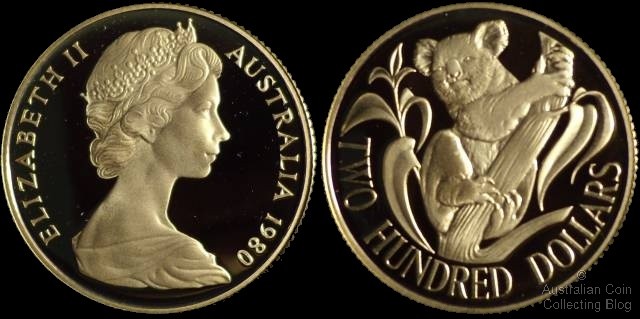 Gold Australia $200 - Koala Reverse
Gold Australia $200 - Koala Reverse
Shown above is the 1980 $200 coin from Australia, struck to proof standard. It was minted from 10.0 grams of 0.9167 fine gold (22 carat) which converts to 0.2948 ounces of gold. At the time of writing the gold content of this coin was worth about US$274 but you can check todays value using our Gold Coin Calculator. The obverse of the coin depicts the Arnold Machin portrait of Queen Elizabeth II, the head of the British Commonwealth. The reverse depicts an Australian Koala sitting in a eucalyptus tree. The $200 gold coin with the koala reverse was minted in 1980, 83, and 84 with the Machin obverse and in 1985-86 with the Raphael Maklouf portrait of the Queen. It was struck in both uncirculated and proof versions each year. Mintages started at a high of over 200,000 uncirculated coins and 50,000 proof coins in 1980 slowly dwindling to 15,298 / 16,654 in 1986.
These are an interesting coin because it wasn't that long ago that the best thing to do with them was to take them to a bank and redeem them for face value. The high issue price in 1980 ($240 for the UNC version), low bullion value and the relatively large mintage for such an expensive coin means that the opportunity for capital growth isn't really there. It has only been in the last 18 months of high gold prices that the coins started fetching amounts well above the face value of the coin. Even now, 29 years later the coins are only just reaching the issue prices again. I know of people who bought 10 or 20 of these coins in 1980 because they were promoted heavily and it is sad to think that they are only just now looking like recouping their initial investment. Hardly the way to get rich! Still they are beautiful coins and lovely to look at in proof form. And barely cost a premium above their gold value. Certainly a fun way of holding the yellow metal!
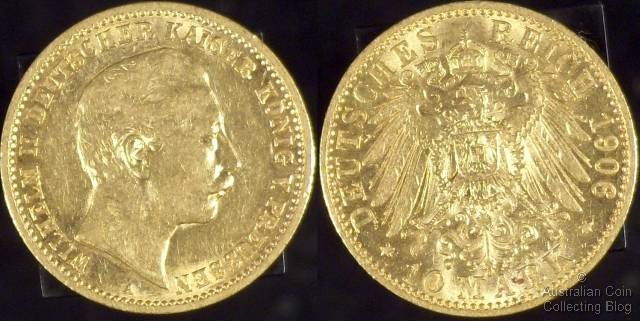
Gold Prussia 1906 10 Mark
Shown above is the 1906 10 Mark coin from Prussia. It was minted from 3.982 grams of 0.900 fine gold which converts to 0.1152 ounces of gold. At the time of writing the gold content of this coin was worth about US$108. The obverse of the coin depicts the portrait of King Wilhelm II of Prussia, who also happened to be the Emperor of Germany. This Wilhelm II is the same famed Kaiser who was in charge of Germany during all of World War One when he was known mockingly as Kaiser Bill by his enemies. The reverse shows the so called Type III German Coat of Arms. The reverse also shows the A mintmark which was Berlin, where 542,000 of these coins were minted for circulation in 1906. Interestingly a very small number (150) of proof strikings were also made in 1906.
This is an interesting historical coin that is available for not much more than the value of the gold it contains. In 1871 when German forces defeated France in the Franco-Prussian war the German Empire was formed. Prussia was the major state of this new empire and it's king, King Wilhelm I was declared Emperor (Kaiser) of the empire. The new empire consisted of 4 kingdoms, 18 dukedoms, 3 free cities and the region of Alsace-Lorraine. The Empire of Germany and the Kingdom of Prussia were brought to an end with Germany's defeat in World War 1. As you can see, there's a lot of history to be found in such a deceptively small coin! Yet another reason why coin collecting is such a fascinating hobby.
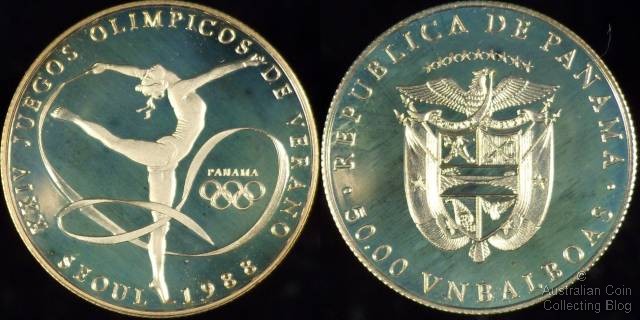
Gold Panama 1988 50 Balboas
Minted from 8.5 grams of 0.999 fine gold the 1988 50 balboa coin from Panama commemorates the 1988 Seoul Olympics. The obverse depicts the great seal of Panama while the reverse shows a freestyle gymnast performing the ribbon disclipline. The 8.5 grams of 0.999 pure gold amounts 0.2733oz which at time of writing was worth US$256. The coin above resides in a plastic capsule and is struck to proof quality, the coin does have some hazing though which explains the murkiness of the fields in the image above.
It's an interesting coin I picked up mainly for it's gold content. The first thing to note about it is that it is NOT listed in the Krause Standard Catalogue of world coins. Well not mine anyway and mine is a few years old. The second thing to note about it is that there is almost no information concerning this coin available on the internet. Upon doing some more research I believe this 'coin' might actually be a pattern rather than an actual legal tender coin. There is a similar pattern commemorating the Winter Olympics from the same year. This coin is the same but depicts a figure skater on the reverse rather than the gymnast. I do suspect the coin was minted by the Franklin Mint, as they struck almost all of the Panamanian collector coins in the late 1970's and 1980's.
That's about all I know about it. If you know anything about this coin please email me and let me know!
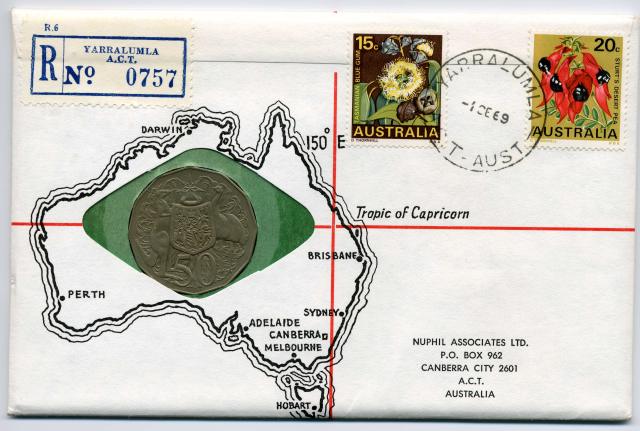 Australia 1969 Yarralumla PNC with 1969 Specimen 50 cent
Australia 1969 Yarralumla PNC with 1969 Specimen 50 cent
In the first part of the Australian 50 Cent Coin Value entries I talked about some of the more valuable circulation coins and the relative lack of value of the commemorative 50 cent coins. In this second part I'll talk about some of the real rarities that you'd be staggeringly lucky to find in your change. Still, the coins exist and if you're really really lucky you might find one. You might have a better chance of winning the lottery though, so don't start counting your money just yet.
- 1977 Coat of Arms Reverse - for some reason the Royal Australian Mint released a very small number of 1977 50 cent coins minted with the Coat of Arms reverse rather than the Silver Jubilee reverse. An EF example of one of these is estimated to be worth $4000.
- 1975 Australian Obverse / Fijian 50 cent Reverse - I've seen some references to this coin, but I have no idea of it's worth or even if it actually exists. The Fijian 50 cent was the same shape as our coin and the RAM actually minted Fijian coins in that year so I guess this could happen.
- 1988 Coat of Arms Reverse - similar to the 1977 coin, some coins seem to have been minted with the Coat of Arms reverse rather than the First Fleet Bicentenary design. An uncirculated example of one of these sold in 2006 for $5400.
- 1969 Specimen 50 cent. These were struck for the Yarralumla PNC. 1330 made it into envelopes and possibly others were put into circulation, it is unknown how many. An UNC version is worth $150.
- 2000 'incuse' Millennium - For whatever reason it appears that a single die run of 2000 Millennium 50 cent coins were run with a die variety. The cross on Union Jack in the Australian flag on the reverse is incuse rather than in relief as is normal. It is estimated that about 200,000 of these coins exist and they are worth $200 in uncirculated condition. Actually if you look for these coins you might be lucky enough to still find one. It wont be uncirculated but it will still be something of a scarce coin.
That's it for 50 cent coin values. There's a bunch of NCLT issues of fifty cent coins that you might be lucky enough to find in circulation, and then there's the ridiculously expensive gold 2009 50 cent coin but you wont find one of those any time soon!
Not too long ago, Walter Eigner released a new online value system for Australian Pre Decimal coins. Walter runs an online coin business, a grading service, a coin imaging service and I think is the current president of the ACT Coin Club. He must have lots of energy because there's no way I'd have time for all of these things! The interesting thing about his new online price reference for Australian coins is that it is continually updated on the basis of actual sales of slabbed Australian coins (he monitors sales of PCGS graded coins, NGC and his own CGAU graded coins on Ebay and several other major sellers of Australian coins). This means, that in theory, that the prices his guide puts forward are much more current than those found in the most commonly used catalogue, Greg McDonalds Pocket Book of Australian Coins and Banknotes.
The online coin value service comprises three offerings:
- The Blue Sheet - the selling prices of Australian coins, this is what you can expect to pay for a given coin of a given grade.
- The Green Sheet - this is the price at which coins of a given grade are marketed at by dealers who generally use the adjectival grading system.
- The Red Sheet - this is what you might expect sell a coin for of a given type or grade. He calls this the 'wholesale' price.
Each of the services is a subscription service, you can subscribe for a period of a month or more, and can bundle each of the services up for discounted pricing. For example, you can subscribe to the 'collector plus' service which gives you access to all three services plus allows you to enter a want and sell list for AU$25 for a month.
In addition to the up to date pricing the services also provide a number of useful tools for collectors and dealers. These include:
- PCGS and CGAU certification number lookups
- Being able to create a want list for other subscribers to see
- Being able to create inventory for sale for other subscribers to see
- Being able to add sales events to the catalogue to allow the sale value to reflect on the current pricing of that coin / grade
- Being able to view coin values in a number of different categories
- Finally, the system is also available as a mobile service so you can see catalogue values via a mobile device like a phone or handheld PC.
Now onto the service itself. I spent sometime browsing through each of the services with
a collector plus subscription. The interface of the system is clean and easy to use. Most pages have explanatory notes at the bottom describing the purpose of each page and how each of the tools might be used. The catalogue pages themselves are laid out by denomination and each year and strike type has it's own line. So, for example, the 1910 3d has a line for the circulation strike and a line for the specimen strike. Each line contains the mintage and values for the coin in grades from F12 to MS65. The greensheet does not provide sheldon grading but rather Australian adjectival grading. I can only assume this is because almost all Australian dealers still sell coins using this grading standard even if a coin is slabbed.
For a lot of the coin types there are notes and remarks by Walter himself on the coin, it's general level of strike and availability and other collector tips. These are very useful information to the new collector. If there is any sales history, want list, or inventory list for a coin of a given type and year then you can click on the year of that coin and view this information. For example, for the 1910 Florin, at time of writing, the following information was presented:
Retail Offer: December 2008, PCGS MS 63, $4750.00, Walter Eigner Numismatics
Retail Offer: January 2009, PCGS AU 55, $800.00, Ebay
Sale: February 2009, PCGS XF 40, $252.00, Ebay
Retail Offer: March 2009, PCGS AU 55, $999.00, Private
So, reviewing this we can see that three PCGS coins have been offered up for sale in the last 4 months, I assume the Private offering is a subscriber of the service, the Walter Eigner offering is dealer stock, and the others have been entered into the system as they were seen on Ebay. Now, if we examine the CV's for AU55 1910 florins in his service we see $1450 on the green sheet, $950 on the blue sheet, and $750 on the redsheet. This suggests that you could find an AU 1910 florin for sale on a dealers list for $1450, but this would be graded AU58 (generally) in a slab. An AU55 coin could be had for $950 and would expect to sell one for $750. It's all quite clear and presumably related to the actual sales and offer history somehow.
It's worth commenting on some quirks of the interface of the system. Firstly, sometimes (for whatever reason) the system wants you to login twice. This is probably a simple programming issue but should still be fixed up. Secondly, the systems dont work well if you are logged into all three price guides at once, so when you are logged into the bluesheet and the redsheet you'll always see the blue sheet pages whatever you do. This could be easily fixed up by using a different set of cookies for each site and should definitely be addressed.
Now I'll comment on the usefullness of the service. Firstly, it needs to be understood that the market for certified and graded Australian coins is still thin, which means that the prices for a lot of the coins do not update very often at all, simply because there's no sales history. Secondly, while the want list and dealer sales inventory are admirable tools they again rely on a critical mass to make them really worthwhile, and it doesn't seem as if right now that critical mass exists. Those things out of the way, the set of tools and catalogue prices are genuinely useful to the Australian coin collector. And the monthly subscription model makes it a bargain priced option if you are wanting to do some research on what your collection is worth or what you should be paying for that graded coin you have your eye on. If you're contemplating spending more than $100 on a coin why wouldn't you pay $3 for a months access to the system? Those lousy three bucks could save you tens or hundreds of dollars by simply seeing how much the coin you want has been selling for in the past!
Walter is to be commended for his effort here. The three price guides appear to be useful research tools for the collector and coin purchaser. The prices of the service are such that it's almost a no brainer to subscribe for a month. Unless you're a dealer I dont really see the point of subscribing for more than one month at a time. That being said it's only $26.95 to subscribe for a year to the collector level service so you're not going to go broke even if you do subscribe for longer. The tools are well worth the look, if you haven't seen them yet go take a look now.
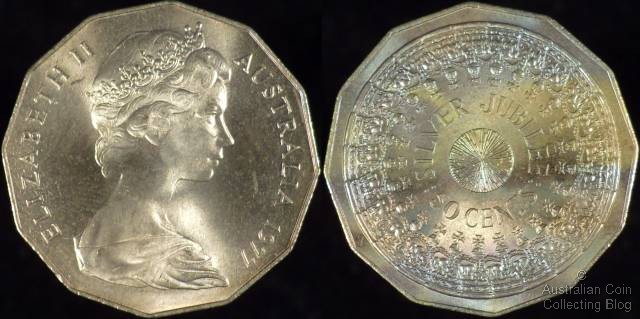
Australian 1977 Silver Jubilee 50 cent
One of the most popular Australian coins to collect is the 50 cent coin. And one of the most popular question about Australian coin values that we get is of course, about what the 50c coins you might find in your change are worth. That's because the 50 cent coin is big, it has been issued with many different commemorative designs since it's release in 1966 and the large size of the coin means the designs really stick out when you receive them in change. Sometimes you'll get a 50 cent in your change and you'll turn it over and Captain Cook will stare back at you and you'll either have never seen one before or not have seen one for years and you'll think....how much is that worth? It must be worth something right? It was minted 38 years ago and you almost never see them any more! Surely an old Australian 50 cent coin is worth some money? After all, some of them are more than 40 years old now!
Well a lot of the time that fifty cent you don't remember seeing before is usually worth...wait for...50 cents. Yes, 50c. Sad but true. See the thing is, a lot of these commemorative coins were minted, and when I say a lot I mean a lot. After all. they were intended to circulate so the Royal Australian Mint churned them out in their millions and tens of millions. The other problem is that the public at the time hoarded these things so there are tens of thousands of money boxes loaded down with uncirculated or near uncirculated examples of them. So sadly most Australian 50 cent coins are anything but rare. It's worth having a look at the mintages of the commemorative 50 cent coins up until 2000 and the catalogue values of an uncirculated example (there have been a spate of them since then, and I don't think it's worth covering them). The mintages and CV's are from the 2009 Pocket Guide to Australian Coin and Banknotes.
- 1970 Captain Cook Bicentenary 50 cent, mintage: 16,548,100, $7.00
- 1977 Silver Jubilee 50 cent, mintage: 25,067,000, $4.00
- 1981 Royal Wedding 50 cent, mintage: 20,000,000, $6.00
- 1982 Commonwealth Games 50 cent, mintage: 23,287,000, $4.00
- 1988 First Fleet Bicentenary 50 cent, mintage: 8,990,800, $15.00
- 1991 Decimal Anniversary 50 cent, mintage: 4,704,400, $10.00
- 1994 Year of the Family 50 cent, mintage: 20,830,800, $12.00
- 1995 Weary Dunlop 50 cent, mintage: 15,869,200, $7.00
- 1998 Bass and Flinders 50 cent, mintage: 22,426,000, $7.00
- 2000 Year 2000 Millennium 50 cent, mintage: 16,630,000, $7.00
So these are the prices you can expect to pay for an example of these coins. When you come to sell them expect considerably less. If your 50c coins are not truly uncirculated expect to get offered face value (though you may get a little more if you try selling them on eBay).
You'll find that some normal circulation coins have much lower mintages than the commemorative coins, and the fact that they were not hoarded means they can be worth a little more. And before I get onto those, the 1966 round 50 cent is not rare and nor is it particularly valuable. It does have real silver in it though which is different to all the other 50 cent coins issued and makes it worth a bit even if it is a banged up circulated coin. So what is the round 50 cent coin worth? It depends on the silver price of the day. You could take a look at our Aussie silver coin value calculator to work it out.
Anyway, back onto the circulation issues. Truly uncirculated 50 cent coins from 1969 (cv $25), 1971 ($25), 1972 ($55), 1973 ($60), 1974 ($35), 1985 ($13), 1993 ($22) , and 1997 ($30) are all worth more than any commemorative 50c coin. In fact some of the mintages are small by comparison, the 1985 and 1993 coins had mintages of less than 1 million and may be worth putting away for the future if you find them even if they have been circulated. In, fact, these days hardcore decimal collectors are looking for the best quality uncirculated 50 cent coins they can find for their collections. So, if you do have a sparkling UNC 1973 50 cent coin you might get a bit of money for it if you list it up on an online auction site.
In the next issue of this series I'll cover some rare and valuable 50 cent coins you can look for in your change. These wont show up too often but they are worth keeping an eye out for.
Other Australian Coin Values
Of course if you're looking for the value of other Australian coins then you're going to find some of our other articles helpful. You might find out value of Australian 20 cent coins article useful, or this one that talks about what Australian dollar coins are worth. We've even got a more general article about rare decimal coins you might find in your change. Of course Australia didn't just mint coins, we've also produced banknotes and if you've got any old paper banknotes then you might want to find out what your old Australian paper banknotes are worth.
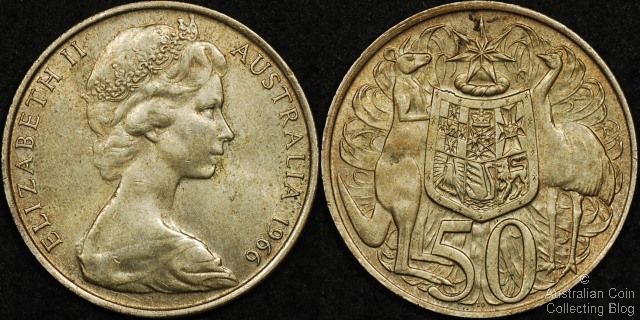
Australia 1966 50 cent
We think of the Australian 50 cent piece as being a cupro-nickel dodecagonal shaped coin but did you know they were originally issued as a round shape? In 1966 when Australian currency changed from the pounds, shilling, and pence sytem to the decimal system the circulating 50 cent coin still had the Coat of Arms design as we know today. The obverse was the same as the other decimal coins at the time, the young Queen Elizabeth II Arnold Machin portrait. When it was originally issued with this round shape in 1966 it contained 80% silver so today is most commonly traded as silver bullion.
Did you know that the round silver 50 cent you found in grandad's desk drawer is worth well over fifty cents! You can check today's value of multiple round 50 cent coins and bullion coins on our Australian Silver Coin Calculator. It's quite a handy tool to keep up with the current value along with any other gold or silver bullion coins.
The current value for a single round 50 cent coin is AU$19.33 (US$12.66). This value is updated every hour or so using the current silver price and exchange rates from Kitco.
What a surprise to see a brilliantly gold dodecagonal 50 cent piece, quite a difference to our circulation Cupro-Nickel examples. For a hefty $2995 you too could own a 2009 dated gold 50 cent to mark the 40th anniversary of the first dodecagonal 50 cent first minted in 1969. This is a RAM struck coin minted for a "corporate order" as stated in the Downies sales ad. Hmmmm, what does that really mean??
The 2009 gold 50 cent features the Arnold Machin effigy of Queen Elizabeth II, the original portrait of the Queen as struck on the original 1969 issues. With a tiny mintage of just 800 coins struck of 0.999% pure gold weighing in at 33.63 grams. Just over a troy ounce of gold, this equates to approx $1520 worth of gold at current prices. Is it overpriced?
My opinion is yes, but if you are a keen collector of the 50 cent series it's going to be a must have..... if you can afford it. Born out of the lack of gold set issue for 2009, the 50 cent on it's own is much more achievable than an entire decimal coin set in gold for this year, imagine the price the RAM would put on that this year!
The gold sets were issued in 2001, 2005, 2006 and 2007 so it hasn't been a constant theme for the RAM to issue the sets. They have been limiting these to the more commemorative years. The price of gold rising steadily has obviously got the RAM marketing department thinking. An entire gold set would be an impossibility for an average collector but a single coin might just be achievable.
This coin is a real beauty, it's hard to say whether this will be a sellout or a flop issue. That's how it goes with coin collecting, sometimes it's potluck if you're collecting for profit but if you're collecting out of need then this is a must-have.
The interesting misconception that came about through my research for my previous article on Star Notes was (from a coin collectors uneducated about banknotes view) that myself and other numismatists I know always just assumed that a star note was the same numbered note as the faulty note but with a star on the end denoting that it was a replacement (this star replacing the last digit of the serial number) .This is because a star note has one less digit in the serial number.
A question was put to me that if there were two soiled notes in a run of ten then there would be 2 identical star notes wouldn't there -because the star replaced the last digit of the serial number?
This is incorrect, a completely separate run of notes is printed. Then one is just slipped into the bundle when a soiled note is found. Therefore the star note's serial number has no relationship at all to the soiled note that it replaced.

Panama 1976 20 Balboa Proof
Panama had circulating silver coinage from 1904 up until 1966, and also produced non circulating legal tender coins in the 1970's. The silver dollar sized 1 balboa coins and the very large 20 balboa coins of 1972-1976 are often available in good condition at little more than the value of their silver content. The availability of these coins as bullion and the availability of the lower denominations in worn condition at melt value can make them an ideal way of accumulating silver. To help you with this I've just created a new silver coin calculator specifically for Panamanian coins. Please take a look at the Panama Silver Coin Calculator and let me know if you want some coins added or if I've made an error.
In addition to our popular silver coin calculators which have grown from Australian Silver coins to include United States, Canadian and New Zealand silver coin calculators, we have now launched another site where you can find out what your Gold Coins are worth.
Our coin calculators are simple to use all you need is to type in the quantities of coins you have and it works it out automatically for you. The calculators get their current gold and silver prices directly from Kitco and you can change the currency into which ever you prefer. You can't get a more easy to use up to the minute system for tracking your coin values.
If your coin isn't listed in our gold calculator and you'd like to see it included please email us and we'd be happy to include it for you.
Australian Pre-decimal coins were minted in various locations here in Australia and overseas. To indicate where coins were minted they were often stamped with verifying marks such as letters or dots known as mintmarks. These letters or dots were always incorporated onto the dies and were struck with the coins. Some decimal coins have their mintmarks applied after striking. With some issues there were variances in the dies which were later used to determine which mint the dies originated but this is not necessarily their mint of origin.
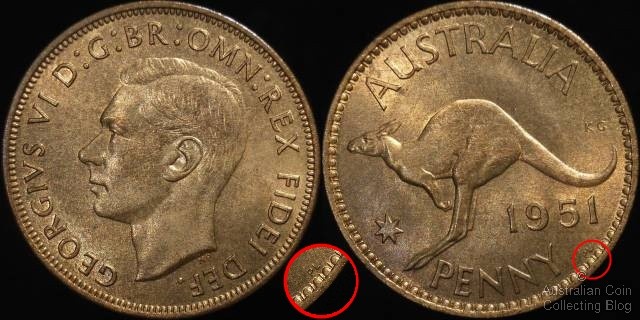
Australia 1951PL Penny
Early George V obverse pre-decimals were struck at either London at the Heaton Mint in Birmingham or in India at the Calcutta Mint. The London struck coins had a tiny H below the bottom scroll on the reverse and the Indian coins have an I in the same position. In 1919 and 1920 Australian struck pennies were mintmarked with dots denoting their mint of origin. A dot below the bottom scroll indicated being struck at the Melbourne Mint or a dot above the bottom scroll indicating the Sydney Mint. From 1916 to 1921 for the threepence and sixpence, an M below the date on the obverse indicated being struck at the Melbourne Mint. Shillings (in 1915) and florins (1914 and 1915) with the Coat of Arms (George V) carried a H below the date on the reverse for the Heaton Mint or an M for the Melbourne Mint (1916-1919). Sydney minted shillings for 1921 only carried a star above the date.
The iconic kangaroo reverse of the halfpenny and penny shows us a dot after the Y of penny or a dot after the last A in Australia was for the Perth Mint. A PL after the Y indicates London Mint. An I mintmark on the obverse indicates India. On the penny designed by George Kruger Gray a dot between his initials K.G indicated the Perth Mint.
The wheat stalk reverse design of the George VII threepence showed either S, D or PL mintmarks. A clear S or D can be seen after the last E of threepence indicating S for San Francisco Mint or D for Denver Mint. For London minted coins a separated P and L can be seen either side of the base of the wheat seeds at the curve of the ribbon.
The sixpence with the George VII obverse displayed letters above the date. These were either S for San Francisco, D for Denver or PL for the Royal Mint in London.
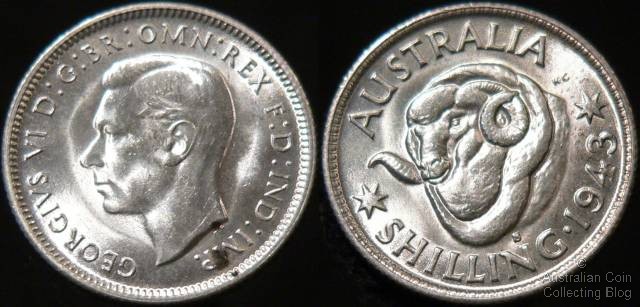
Australia 1943 S Shilling
The ram reverse design shillings denoted an S mintmark above the N of shilling for the San Francisco Mint. A dot after the star and before the S of the word shilling indicated the Perth Mint. .
The Florins of George VII showed only one mintmark and this was a tiny S above the centre of the date indicating the San Francisco Mint.
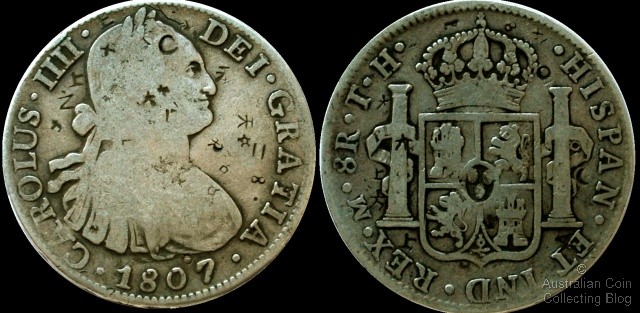
Spain 1807 8 Reale - Mexico Mint, Numerous Small Chopmarks
Chopmark : a stamped symbol or letter punched into a coin to signify that it has been assayed for weight or purity by an Asian bank or trader.
In my last entry I talked about trade coins, coins produced to make economic commerce between countries easier. China was the major trading partner in Asia for a large number of Western countries and a lot of the large silver trade coins were designed specifically for trade with China. The Chinese produced a large range of manufactured goods that were in demand in Europe but they were not interested in European goods, what they really wanted was silver. The 8 reale (in cob and milled form) was the trade coin of choice for hundreds of years until they stopped being minted in 1821 when Mexico declared it's independence.
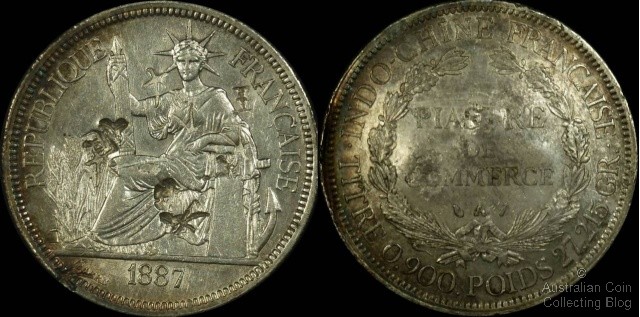
France 1887 1 Piastre - Dish shaped due to heavy central chopmark
To understand chopmarks you must understand the Chinese attitude to silver coins in the 17th through to the early 20th centuries. The Chinese saw silver coins as round pieces of bullion, tradeable silver, not money at all. In fact a lot of the time they melted such silver coins down into ingots called sycee that traders had traditionally traded with. Being bullion, traders and customers needed to have confidence in it and thus chopmarks, symbols, letters or Chinese characters were stamped into the coins with metal punches to signify that a trader or bank had assayed the coin and determined it to be genuine. This is little different to the practice of hallmarking silver and gold in Western countries. The practice of applying chopmarks became especially important because of the circulation of debased counterfeit 8 reale coins or base metal counterfeits with a thin silver coating. The punch used to create the chopmark could penetrate the thin silver out coating of these counterfeits and reveal the coin to be the fraud it was!
In the second half of the 19th century and early 20th century a larger number of nations started producing 8 reale sized silver coins to assist their traders in doing business with Asia. For example, the US Trade Dollar was produced to stop American traders having to purchase Mexican 8 Reale coins at a premium. This influx of new and unknown silver coins into China lead to an increase in the size and number of chops applied to silver coins in trade. These coins could be very heavily chopped to the point of having the design almost obliterated and the coin itself being formed into a 'dish' shape due to the large force applied when the chopmarks were made by traders.
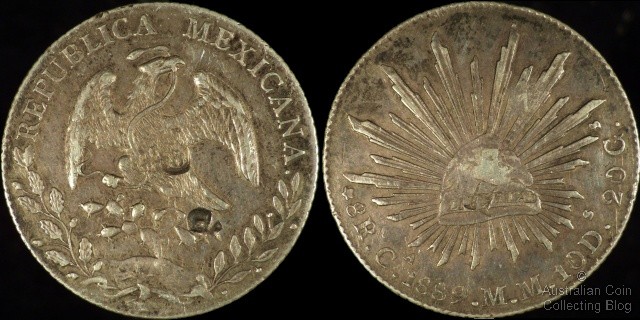
Mexico 1889 8 reale - Chinese character and Latin 'H' Chopmarks
Chop marked coins are (in my opinion) just bursting with character. The marks and resultant effect of the coin makes the coin itself a relic of another era where international trade depended on the quality of the silver rather than on electronic fund transfers. The chopmarks are exotic and strange an often completely at odds with the design of the coin they are on, providing an interesting contrast in the cultures of the time. One can only imagine English traders in the early 19th Century bartering for silk and porcelain from Chinese traders using Spanish colonial silver purchased with English silver or even stolen from Spanish ships by English privateers! These sorts of coins are, to me at least, part of what coin collecting is all about.
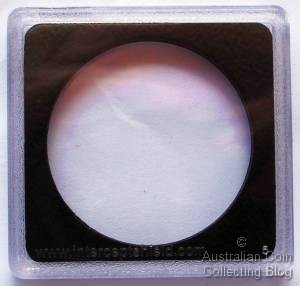
An Empty Intercept Shield 2x2 Coin Holder
I am continuing to look for an ideal way to store my coins so I can move away from using cardboard 2x2 holders. One option I am currently investigating is the Intercept Shield 2x2 holder. The primary reason I am interested in them is their supposed archival quality storage properties and that they may fit in Eagle 2x2 album pages allowing me to store my collection for easier viewing. The Intercept Shield 2x2 coin holders comprise three components, two inert colourless plastic halves that snap together to form the outer case of the holder. The coin is retained by the third component, a stiff black foam type plastic insert with a hole for the coin and that is retained by the outer case. You can see an un-assembled holder below.

Intercept Shield 2x2 Coin Holder Components
To fit a coin to such a holder you simply need to purchase a holder with the correctly sized hole for the coin. The black plastic is quite stiff, much stiffer than the inserts in the air-tite coin holders I've spoken about previously. This means you need to purchase holders whose hole diameter isn't more than 0.5mm smaller than the diameter of the coin or the coin won't fit or will be very difficult to put into the holder.
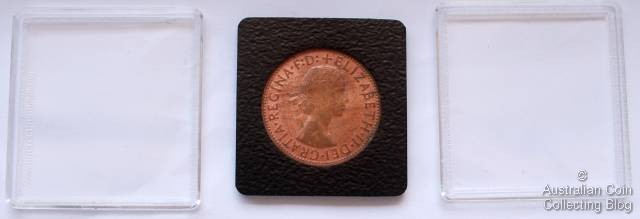
Intercept Shield 2x2 Coin Holder Fitted with Coin Ready for Assembly
Above you can see an Australian penny fitted to the black plastic insert. The coin fits snugly and cannot move within the insert. To put the holder back together is simply a matter of fitting the insert and coin to one half of the outer case and snapping the other half together with it.
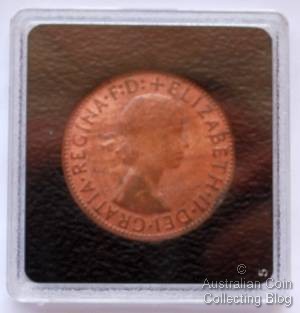
Intercept Shield 2x2 Coin Holder Fitted with Coin
Assembly only takes a few seconds and is significantly faster and easier than putting a coin in an Eagle 2x2 Coin holder. The holders themselves are quite attractive and allow for easy viewing of the coin. Of course having the coin retained by the black insert means you cannot view the edge of the coin.
I should comment on the supposed archival storage quality of the Intercept Shield 2x2 coin holders. The holders are supposed to be excellent for maintaining the condition of a coin and preventing toning of coins and preserving mint luster of silver and copper coins. In fact the black plastic insert is supposed to be some sort of sacrificial material that will attack and neutralise any gasses that enter the holder and prevent them from effecting the coin it retains. I am not sure exactly how this happens and given the time I've had them of course I haven't tested this side of them but if you're interested you can read more about it here. There's also an interesting long term test you can read about. This test was carried out by the parent company of Intercept Shield and contains some pretty spectacular results.
Concluding Comments
Given that I can find folder pages for these holders I may end up using them. They are attractive and easy to use and seem to do the job in terms of preserving the coins they hold. The only real problem I have with them is the sizes of the inserts. They are specifically designed for US coins (as most things are) and thus some Australian coin sizes dont translate very well. The half penny and florins are very tight squeezes indeed. I'll try a number of them and draw my own conclusions. If they really are too tight then I'll have to keep looking for another storage solution.
If you're interested in 18th or 19th century coins it wont be long before you come across the term 'trade coinage'. Trade coinage covers coins that were not really intended to circulate in their home countries, but rather to act as a medium of exchange of bullion of a known quality and quantity between different countries. Such trade coinage from different countries tended to adopt very similar mass and fineness of precious metal to help make the coins more readily accepted in the markets in which they were intended to trade. The biggest areas that trade coinage found circulation was in South America, China, and the Middle East.
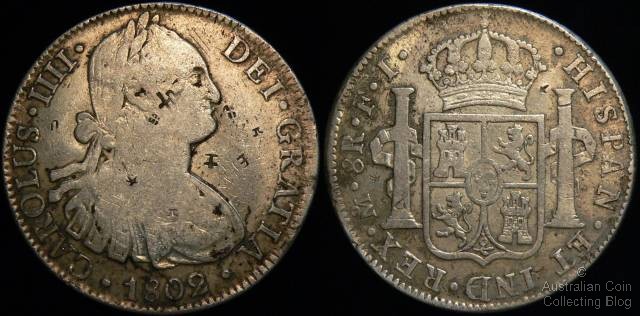
Chop Marked Spanish 8 Reale Mexico Mint
One of the more famous 'trade coins' is the milled Spanish colonial 8 reale, which was minted in the 18th and 19th centuries. Minted of 0.903 fine silver it weighed 27.07 grams (0.7861oz ASW) and formed the basis of most silver trade coinage for the next 150 years. It was traded in many countries and was the first US 'dollar' and formed the basis of their original currency. In fact, the slang for the US 25c coin of 'two bits' dates back to the period where 8 reale coins were cut up into 8 equal parts for small change, and 25c was 'two bits' of this cut up coin. It traded right through the Asian regions, Australia, Europe, and formed the basis of counter stamped emergency silver coinage in England in the early 19th century. It also found usage as currency in Brazil and India where it was over-struck to produce local currency.
The Spanish colonial 8 reale formed the basis of a whole range of large silver coins designed specifically for international trade. All of these coins had very similar silver content and varied slightly in mass and fineness. Countries strove to make their trade coin the accepted medium of trade by increasing the actual silver weight of their coins slightly to make them more attractive to foreign traders. Examples of trade coins that circulated in China and other Asian countries in the latter half of the 19th century and early 20th include:
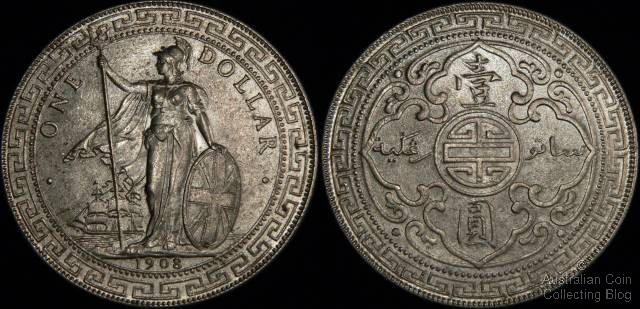
Great Britain 1908 Trade Dollar
- USA Trade dollar, 27.0 grams, 0.900 fine silver, 0.7814oz ASW
- Japanese Trade Dollar, 27.22 grams, 0.900 fine silver, 0.7877oz ASW
- British Trade Dollar, 26.957 grams, 0.900 fine silver, 0.7801oz ASW
- French Piastre, 27.215 grams, 0.900 fine silver, 0.7876oz ASW
- Mexican Peso, 27.073 grams, 0.903 fine silver, 0.7861oz ASW
Trade coinage existed in the form of gold coins as well. Some of the better known gold trade coins include the ducat and the sovereign. Ducats have been struck for hundreds of years as trade coins and are still struck to a standard specification today. Originally minted to a standard in 1566 they remained officially recognised as trade coins until 1857 and as I've mentioned are still struck today as bullion coins. The most commonly recognised ducat is the Dutch ducat but they are still minted in Austria and have been minted in a lot of European countries including Germany, Hungary, Italy, Romania, and Spain. A standard ducat contains 3.4909 grams of 0.986 fine gold which is 0.1107oz AGW.
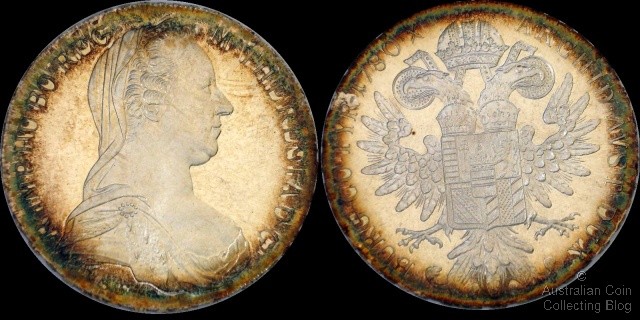
Austria 1787 Maria Theresa Thaler Proof Restrike
In closing this entry it would be remiss of me not to mention the Maria Theresa Thaler of Austria. This is probably the single best known trade coin in history. It has been in production since 1741 in one form or another, with the 1780 thaler being restruck since 1780 until today. It is estimated that nearly 500 million of these coins have been minted. The Thaler contains 28.0667 grams of 0.833 fine silver with a resultant actual silver weight of 0.752 oz. The coin was used as the principal medium of exchange between Europe and the Middle East and parts of Africa for more than 100 years. It was even the official currency in a couple of Middle Eastern countries! According to Wikipedia the coin is still traded in Middle Eastern countries today, testament to it's longevity.
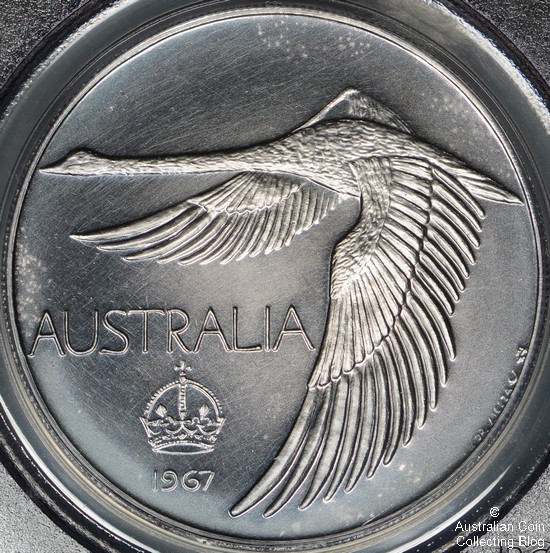
Australia 1967 ACR Pattern Goose Dollar - Obverse
The swan pattern dollar is not an official issue, although it does hold an important part in Australia's numismatic history. It has been nicknamed the "Goose dollar" by collectors and has risen in popularity in the past few years.
When decimal currency was to be introduced in 1966, collectors were surprised to learn that a one dollar coin would not be included in the new issues. So, in 1965 the Australian Coin Review magazine ran a competition and the winning entry submitted to the Australian government. When this coin was rejected by the authorities, competition organizers decided to have it minted privately .
In 1967 it was engraved and struck by John Pinches medallists of London. The design, by Andor Meszaros features a swan with Australia 1967 on the obverse and wattle with 100 (cents) printed on the reverse. On the obverse (swan side) at approximately 4 o'clock right next to the rim are the designers initials which may be mistaken as a scuff on the coin surface.
There were 1500 specimen uncirculated silver coins issued that featured a milled edge, 750 proof pieces with a plain edge and 10 gold with the plain edge. The silver proof was originally available at $13.50 while the silver uncirculated examples were $10. It is believed 2 of the gold coins were lost in the Ash Wednesday fires in 1983 (John Gartner collection) so it could be said that there are only 8 in existence. John's house at Mount Macedon in Victoria was destroyed with the coins along with the actual dies used to strike the coins. All coins were originally issued in a maroon coloured case inscribed with "Australian Pattern Crown" inside the lid and in the case for the proofs, the word "proof" was added.
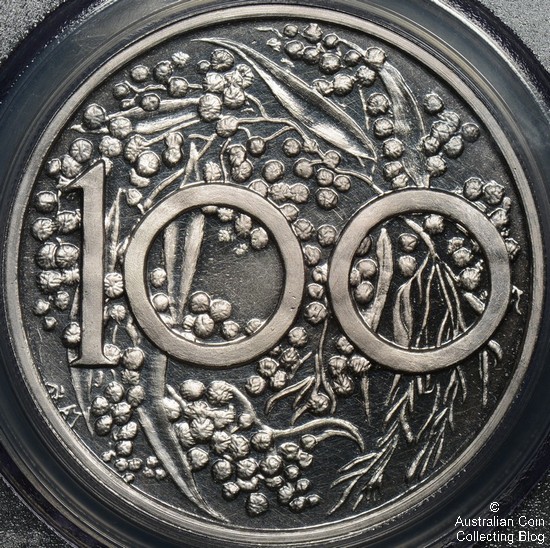
Australia 1967 ACR Pattern Goose Dollar - Reverse
Specifications differ between the gold and silver issues. All are 38 milimetres in diameter and the silver releases weigh 28.7 grams and the 22ct gold 40.3 grams.
McDonald's catalogue (2009) value for these coins is currently $925 for the spec.unc (issued at $10), $975 for the silver proof ($13.50 issue price) and $12,000 for the gold proof. Personally I have never seen a gold type up for sale so it's rarity might see it achieve a much higher figure if there was one offered for sale.
Update: A gold goose dollar sold on eBay in July 2009 for $12, 500. Another gold goose sold at the Nobles Sales 103 in 2013 for $18,000 plus commission on an estimate of $8,000, a very strong price.


